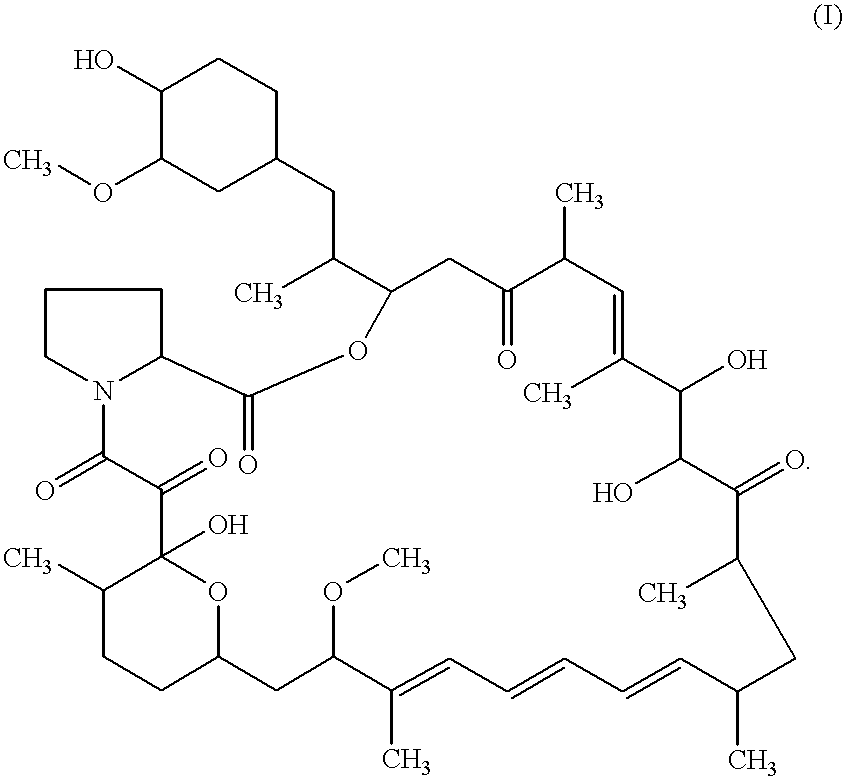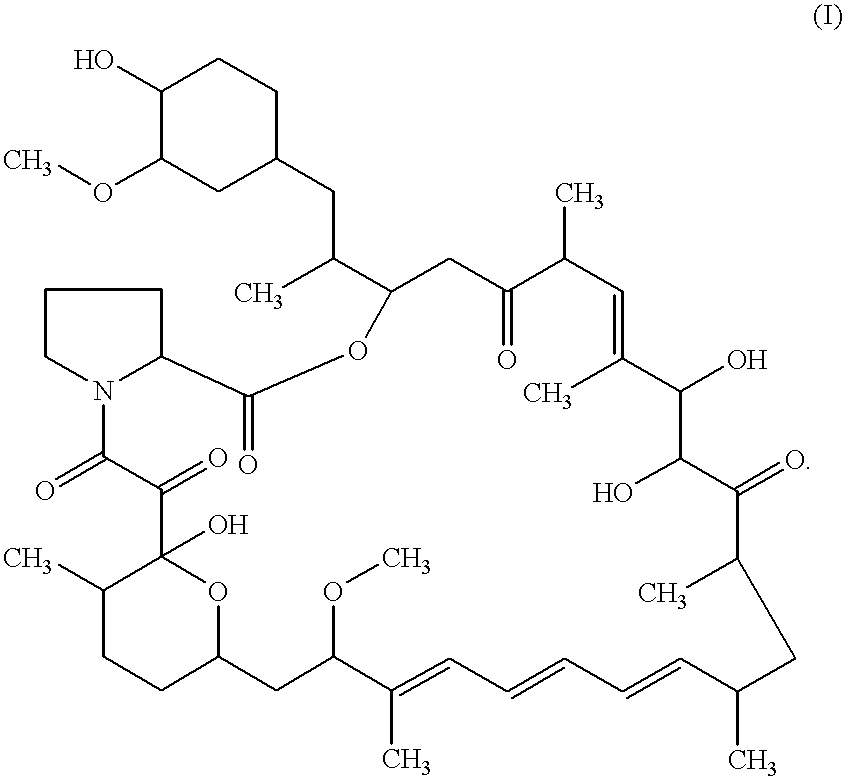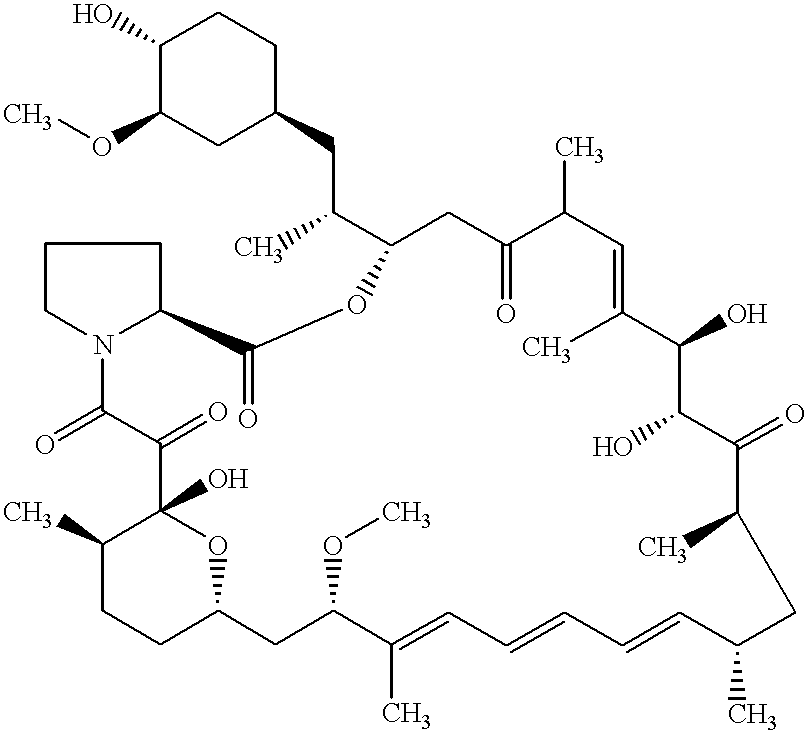Macrocyclic lactone compounds and their production process
a technology of macrocyclic lactone and production process, which is applied in the direction of process and machine control, electrical programme control, immunological disorders, etc., can solve the problems of liver damage, kidney failure, ulcers, etc., and achieve the effect of improving the quality of life and reducing the risk of cancer
- Summary
- Abstract
- Description
- Claims
- Application Information
AI Technical Summary
Benefits of technology
Problems solved by technology
Method used
Image
Examples
example 1
One hundred (100) ml of Medium-1 (glucose 2%, Polypepton 0.5%, beef extract 0.3%, wheat gluten 0.5%, yeast extract 0.5%, blood meal 0.3% and CaCO.sub.3 0.4%, PH 7.0-7.2) in a 500 ml flask was inoculated with a vegitative cell suspension from a slant culture of Actinoplanes sp. FERM BP-3832. The flask was shaken at 28.degree. C. for 3 days on a rotary shaker with 7-cm throw at 220 rpm, to obtain a first seed culture.
A shake flask containing Medium-1 (150 ml) was inoculated with 7.5 ml of the first seed culture. The flask was shaken at 28.degree. C. for 2 days on the rotary shaker, to obtain a second seed culture.
The second seed culture was used to inoculate a 6-liter (L) fermentation vessel containing 3 L of sterile medium (Medium-2: glucose 2%, Polypepton 0.5%, beef extract 0.3%, yeast extract 0.5% and CaCO.sub.3 0.4%, PH 7.2-7.4). Aeration was carried out at 26.degree. C. for 2 days with 1,700 rpm at 3 L per min, to obtain a third seed culture.
The third seed culture in the 6-L ferm...
example 2
The procedure similar to that of Example 1 was repeated except that the amino acid fed was changed from L-proline to L-hydroxyproline, and that Medium-2 was replaced by Medium-2A (glucose 3%, corn starch 1%, Pharmamedia 0.5%, Sungrowth 0.5%, corn steep liquor 0.75%, CoCl.sub.2.6H.sub.2 O 0.0001% and CaCO.sub.3 0.4%, PH 7.2-7.4).
As a result, the eluted peaks were collected to yield compounds CJ-13,503 (1.0 mg) and CJ-13,504 (1.5 mg). The compounds were detected by HPLC using the Pegasil (Senshu's trademark) ODS column (4.6.times.150 mm) and eluting with methanol-water (7:3 to 10:0) for 30 min at flow rate of 0.7 ml / min at 42.degree. C. The retention times of compound CJ-13,503 and compound CJ-13,504 were 10.9 and 11.9 min, respectively. The detection was carried out by UV at 280 nm.
In addition, the physicochemical properties of CJ-13,503 and CJ-13,504 were determined as follows.
example 3
The procedure similar to that of Example 2 was repeated except that the amino acid fed was changed from L-hydroxyproline to L-nipecotic acid.
As a result, the eluted peak was collected to yield compound CJ-13,502 (1.0 mg). The compound was detected by HPLC using the Pegasil (Senshu's trademark) ODS column (4.6.times.150 mm) and eluting with methanol-water (7:3 to 10:0) for 30 min at flow rate of 0.7 ml / min at 42.degree. C. The retention time of compound CJ-13,502 was 12.8 min. The detection was carried out by UV at 280 nm.
In addition, the physicochemical properties of CJ-13,502 were determined as follows.
PUM
| Property | Measurement | Unit |
|---|---|---|
| Time | aaaaa | aaaaa |
| Time | aaaaa | aaaaa |
| Time | aaaaa | aaaaa |
Abstract
Description
Claims
Application Information
 Login to View More
Login to View More - R&D
- Intellectual Property
- Life Sciences
- Materials
- Tech Scout
- Unparalleled Data Quality
- Higher Quality Content
- 60% Fewer Hallucinations
Browse by: Latest US Patents, China's latest patents, Technical Efficacy Thesaurus, Application Domain, Technology Topic, Popular Technical Reports.
© 2025 PatSnap. All rights reserved.Legal|Privacy policy|Modern Slavery Act Transparency Statement|Sitemap|About US| Contact US: help@patsnap.com



